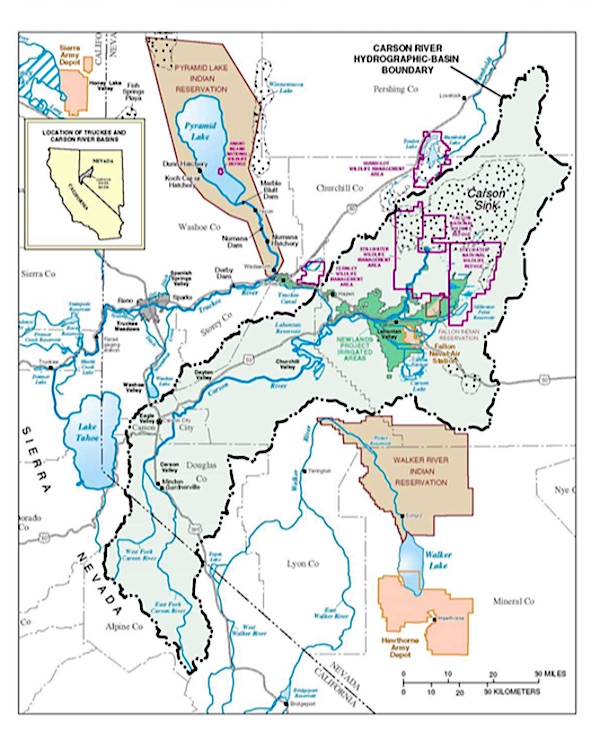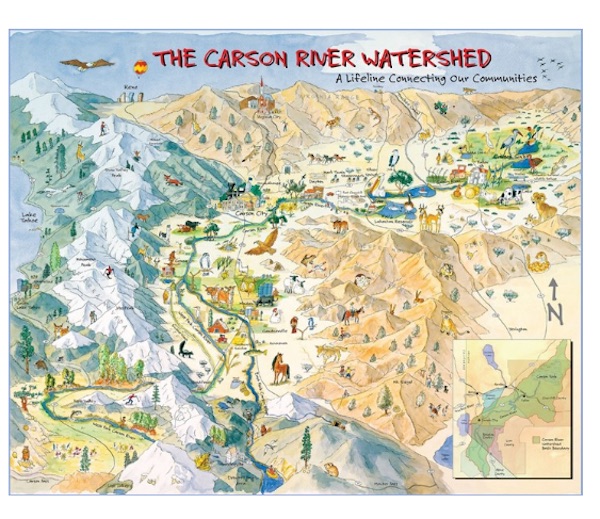The Carson River runs west of Fallon and ends at the Stillwater National Wildlife Refuge.
Photo by Steve Ranson.
Like three other rivers in the Great Basin, the Carson River has been an invaluable tributary for the area’s ranchers and farmers and other users beginning in Alpine County near Markleville, Calif., to the Carson Sink.
Brenda Hunt, manager of the Watershed Program for the Carson Water Subconservancy District (CWSD), and Darcy Phillips of River Wranglers presented information last Tuesday on the river and the importance of water conservation as part of the Churchill County Museum’s fall lecture series on water and the Newlands Project.
Hunt is part of a five-member staff that provides education on the watershed, which depends on the runoff from the Sierra Nevada into the Carson River.
“It’s a 184-mile journey to the Great Basin,” Hunt said, of both the Carson River and the East Fork that empties into the Carson Sink northeast of Fallon. “The river flows north to Carson City and eastward toward Dayton to Lahontan Reservoir and then through Churchill County to the (Stillwater National Wildlife) refuge.” Courtesy of Carson Water Subconservancy District
Courtesy of Carson Water Subconservancy District
Hunt said the terrain is unique and different as the river begins in the alpine peaks of the Sierra and heads toward the marshy land of the refuge, which is known for its wetlands and hundreds of thousands of shorebirds. The largest surface storage area of water west of Fallon is at Lahontan Reservoir, which was completed in 1915 as part of the Newlands Project. The water storage upstream of the reservoir is limited, and the supply is mostly dependent on the winter snow pack in the Sierra Nevada.
The U.S. government’s Alpine Decree divides the East and West Forks, and the Carson River into eight autonomous segments. According to the CWSD, “Transferring water rights from one segment to another segment changes the priority of a given water right. Based on this and other restrictions in the Alpine Decree, the movement of water must be done in a systematic and careful manner.”
From statehood in 1864 to present-day Nevada, Hunt said people have preferred living within the watershed and its fertile ground.
“The rural and urban communities depend on water,” she said.
The river flows through six counties (including the county-city municipality of Carson City), which, Hunt said, includes a large stakeholder group.
The Carson Water Subconservancy District also coordinated with the Carson River Coalition, which launched after the 1997 floods that inundated parts of western Nevada. Their goal has been to manage the health of the river, one of four in the Great Basin. The others are the Truckee, Walker and Humboldt. Hunt said the CWSD monitors the impact of the river from beginning to end.
“Floods are a natural and occasional occurrence in the watershed,” she said adding the CWSD adopted a stewardship in 2007.
The last time the Carson River overflowed its banks came during the winter and early spring 2017. During that time, the Lahontan Reservoir faced an overabundance of water coming into the reservoir. As a result, the Truckee-Carson Irrigation District and Churchill County decided to build an emergency weir and spillway along the V-line canal to drain excess water into the desert and eventually to the Stillwater marshes through a canal referred to as the Big Ditch.
One of the CWSD’s tasks, said Hunt, is to identify flood areas and their potential flood risks. Hunt also said polluted flood runoff into the river has been a challenge. Because of the river’s impact on the area, she said outreach education is a key for a better understanding of the tributary from crops to recreation.
“We want people to gain an appreciation of what it (the river) offers,” she said.
Hunt noted other challenges include invasive species and weeds.
Phillips is executive director of the River Wranglers, which began in 1994 through a grant program and later incorporated as a 501c(3) nonprofit organization in 2000. The main goals of River Wranglers include incorporating water quality monitoring of the Carson River into high-school science programs and providing field experience for students who-live in rural communities along the river. Phillips said River Wranglers wants to make events interactive, hands-on and to make children take ownership of the watershed.
“We love to get them excited about the watershed,” she said.
Both the CWSD and River Wranglers are busy during the year, visiting classrooms, attending various events and working with local, state and federal agencies. They have presented information on the watershed and river to students in Churchill counties as well as setting up booths at Earth Day and Spring Wings. River Wrangles also puts on conserve Carson River work days, Trout in the Classroom, Snapshot Day and flood awareness.
Phillips said flood awareness is important for children to understand.
“It’s estimated 50% of the kids have never seen the river,” she said. Carson Water Subconservancy District
Carson Water Subconservancy District
 Courtesy of Carson Water Subconservancy District
Courtesy of Carson Water Subconservancy District Carson Water Subconservancy District
Carson Water Subconservancy District
Comments
Use the comment form below to begin a discussion about this content.
Sign in to comment